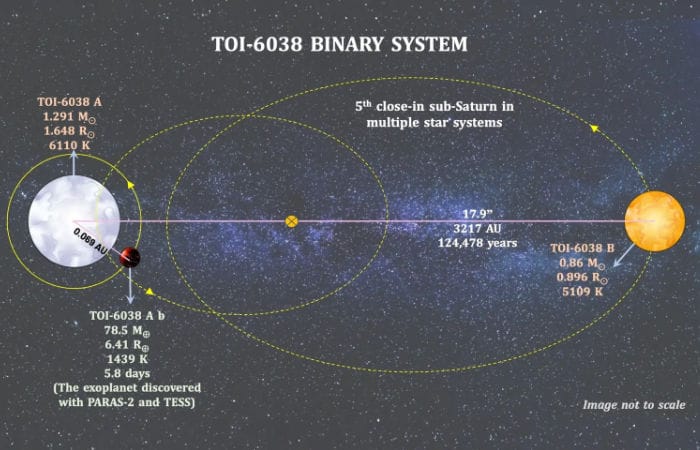Ahmedabad-based scientists at the Physical Research Laboratory (PRL) have made a groundbreaking discovery. They have found a massive alien planet outside our solar system, named TOI-6038A b, as per reports. This planet is so large that it can accommodate 263 Earths within it. The discovery was made by PRL scientists using a telescope at an observatory in Mount Abu.
- Orbit: The planet orbits a bright, metal-rich F-type star every 5.83 days in a circular orbit. The star it orbits is hotter and more luminous than the Sun.
- Binary system: The planet exists in a binary star system which means it has two stars in its system. It orbits one of the stars, while the second star is positioned a little farther away.
- Planet type: The TOI-6038A b lies in the transition region between Neptune-like and gas giant exoplanets, called as “Sub-Saturn,” a category absent in our solar system, providing a unique opportunity to study planetary formation and evolution.
The scientists used a high-tech telescope known as PARAS-2 to discover this planet. This instrument is capable of detecting minute movements of stars.
According to the Indian Space Research Organisation (ISRO) document, TOI-6038A b likely has a massive rocky core making up about 75% of its mass, with the rest being a hydrogen-helium envelope.
This helps scientists understand the transition between rocky planets and gas giants. Its brightness makes it ideal for studying its atmosphere and orbit, which could improve theories on how exoplanets move. Searching for hidden companion planets may also reveal more about its evolution.
Scientists are excited to conduct further studies on TOI-6038A b. Due to its brightness, more research can be carried out in the future. India is progressing rapidly in space research and is eager to discover new planets. This planet is classified as a sub-Saturn, meaning it is smaller than Saturn. Studying such sub-Saturn planets is crucial, as our solar system does not contain such planets, making this an evolutionary research breakthrough.
“This highlights India’s growing expertise in advanced astronomical instrumentation, with the PARAS-2 spectrograph being the highest-resolution stabilized radial velocity (RV) spectrograph in Asia,” said ISRO.



